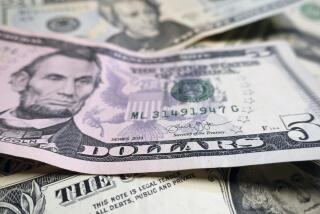How stock, bond and other markets have fared so far in 2025

- Share via
NEW YORK — Global financial markets have been turned upside down this year by President Trump’s burgeoning trade war. Markets are not in full panic, but the double-digit declines in major U.S. stock indexes are testing nerves.
U.S. markets had been on a two-year tear coming into 2025, though many believed that stock prices had become inflated. Trump’s trade war pushed that sentiment into hyperdrive. The Standard and Poor’s 500 has tumbled 13%, and U.S. markets are being outpaced in Europe, Asia and just about everywhere else.
Trading in traditional “safe havens” such as U.S. Treasurys and the dollar has become erratic and unpredictable.
On Monday, the dollar struck a three-year low and U.S. Treasury yields have been soaring. Typically, yields would fall as investors seek a safe place to park their money. U.S. Treasurys no longer appear to provide the shelter they once did.
Only gold, a commodity traded internationally, has maintained its reputation as a safe zone. The price of gold is hitting one record high after another.
Here’s a roundup of what is happening in various segments of the financial markets:
Stocks
U.S. stocks have been losing ground in a sharp reversal after two years of stellar gains.
The S&P 500 index, which is considered a benchmark for the broader market’s health, is down more than 13% in 2025. It gained more than 20% in both 2023 and 2024.
The benchmark index is already in a “correction,” having fallen more than 10% from the record it set in February. There have been only five weeks in which it’s ended in positive territory this year, and with Monday’s decline it’s moving closer to bear market territory, or a 20% drop from recent highs.
It’s worse for the growth-focused Nasdaq composite, which has plunged 19%.
Overseas markets have largely performed much better than their U.S. counterparts.
Bonds
Treasurys, typically considered a less risky area of the market, have been volatile throughout the year.
The 10-year Treasury, which influences mortgage rates and other loans, was as high as 4.80% in January but then fell until Trump announced the broad details of his tariff policy in early April. Yields then began to surge this month. The recent jump in bond yields, which happens when bond prices fall, reflects rising anxiety about inflation and a potential recession.
Treasury bonds are essentially IOUs from the U.S. government and they’re how Washington pays its bills. Bond prices typically move in the opposite direction of stock prices, but prices for both have fallen in tandem. That raises more significant concerns, namely a loss of faith in the U.S. as a safe place to invest.
Gold
In all of the economic uncertainty, gold is soaring — setting record after record in 2025.
The New York spot gold price hit another all-time high Thursday, closing at about $3,343 per troy ounce — the standard for measuring precious metals — according to FactSet. The price is up nearly 27% this year.
Gold futures rose to more than $3,432 on Monday.
Interest in gold soars in times of uncertainty as investors seek a safe place for their money, although there can still be some volatility. The spot price of gold fell for three straight trading days after Trump’s “Liberation Day” announcement on tariffs on April 2, for example, but soon rebounded overall.
Foreign Exchange
The U.S. dollar, the world’s reserve currency, is falling under the weight of uncertainty over tariffs, inflation and the direction of the U.S. economy.
The U.S. dollar is down a steep 9% for the year when measured against a basket of other currencies, including the euro, Japanese yen, Canadian dollar and Swiss franc.
The dollar began to erode almost immediately in 2025, but those losses have accelerated over the last two months. A weakened dollar means it is more difficult for the U.S. government, businesses and consumers to borrow money at lower rates. It also means less purchasing power for U.S. consumers and the potential for stunted economic growth.
Oil
There is good news and bad news about energy prices. The average price for a gallon of gasoline in the U.S. on Monday was $3.15, down sharply from $3.67 at this time last year. That’s the good news.
The bad news is that energy prices fall when people start anticipating an economic slowdown. Factories produce less, families call off vacations and businesses cut travel expenses.
Oil prices hit a four-year low this month with anxiety over the effects of tariffs on global economic growth sinking in.
West Texas Intermediate crude, the U.S. benchmark, stood at about $63 per barrel as of midday Monday. That’s down nearly 14% year to date. And Brent crude, the European standard, was just above $66 — down nearly 13% since the start of 2025.
Economists are warning that the steep tariffs Trump is pursuing could cause a recession, which could carry significant implications for the supply chain and jobs in the energy sector.
Bitcoin
Bitcoin has continued to undulate.
The world’s largest cryptocurrency has been on a roller coaster since the start of the year — with the volatile asset climbing to more than $109,000 ahead of Trump’s inauguration in January, only to dip under $75,000 amid wider market sell-offs this month. As of midday Monday, bitcoin’s going price was above $88,000, according to CoinMarketCap.
That’s more than $6,000 lower than where bitcoin was trading at the start of 2025 — but still significantly higher than in recent years. At this time last year, bitcoin traded around $65,000. And in April 2023, months after the November 2022 collapse of FTX crushed crypto, the digital asset went for less than $30,000.
Trump, once a crypto skeptic, became a major promoter of the industry throughout his campaign — and last month, he signed an executive order establishing a government reserve of bitcoin.
Grantham-Philips and Troise write for the Associated Press.
More to Read
Inside the business of entertainment
The Wide Shot brings you news, analysis and insights on everything from streaming wars to production — and what it all means for the future.
You may occasionally receive promotional content from the Los Angeles Times.










